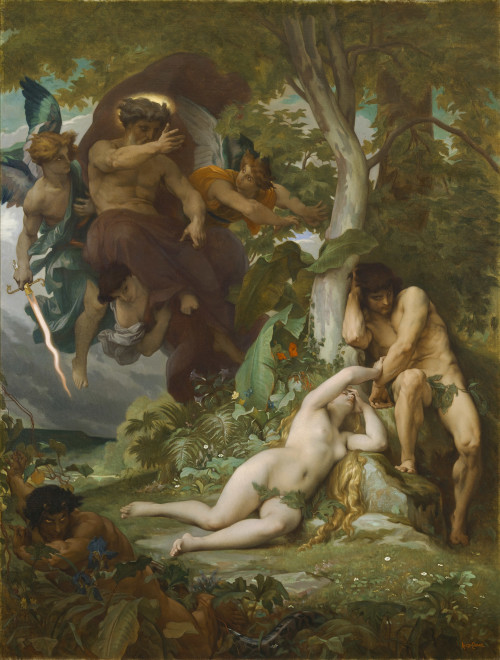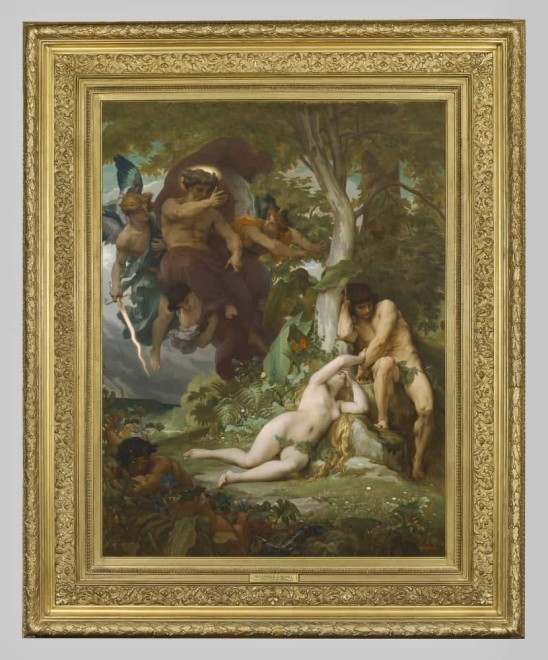Cabanel’s commission of Le Paradis Perdu for King Maximilian II of Bavaria immediately earned him the highest awards and honors and solidified his place as France’s leading academic painter of the Second Empire.
Catalogue note
In 1867, Alexandre Cabanel sent six paintings to the Exposition Universelle in Paris, including three acclaimed portraits and two of his most celebrated works, La Nymphe enlevée par un faune (The Rape of the Nymph) and La Naissance de Venus (The Birth of Venus) (Musée d’Orsay, Paris). Also in this group was the massive Le paradis perdu (Paradise Lost), a new painting depicting the Biblical story of Adam and Eve. This work immediately earned Cabanel the highest awards and honors and solidified his place as France’s leading academic painter of the Second Empire. Its destruction in Münich during World War II might have been one of art history’s greatest losses were it not for the numerous preparatory sketches and detailed versions that Cabanel had made. The present painting, one of only a handful of related works held in private hands rather than in a major museum collection, is the closest to the original in size and composition and the only documented répétition in Cabanel’s expansive oeuvre.
Intended for King Maximilian II of Bavaria as part of a larger tableau of thirty decorative historical canvases for his Foundation “for the gifted,” or Maximilianeum, the commission for Paradis perdu came from the architect-in-charge, Leo von Klenze, in 1862. Klenze had already approached several French artists to participate in the project, but was repeatedly frustrated in his efforts to secure a commission. His eventual decision to appoint Cabanel – little-known in Germany and, at 38, still rather young – was a surprising but profoundly astute one: Cabanel had already, by the 1860s, undertaken many mural schemes, complex iconographic programs, and decorative cycles in public buildings and private residences and his prowess as a religious painter, in the tradition of the great Italian Renaissance masters, had been noted by no less influential a figure than the critic Théophile Gautier. “The Salon painting that most directly follows on from elevated, serious, profound art,” Gautier had written in 1852, “whose prototypes are Michelangelo and Raphael is The Death of Moses by Monsieur Cabanel, Prix de Rome winner in 1845. In his case, his stay at Rome, which sometimes can be detrimental to young artists, has indeed been profitable. One can see how he has eaten the bread of angels [Psalm 78: 25] and nourished himself on the marrow of lions,” (Théophile Gautier, “Beaux-Arts, Salon de 1852,” in La Presse littéraire, 16 May 1852).
Cabanel’s contribution to the Maximilianeum’s gallery of pictures was to be his most important and largest commission for an institution outside of France. That it was also significant for Cabanel himself may be gauged by the number of studies, sketches, and reductions that he made of Paradis perdu. The subtle and often striking differences between these pictures provide a fascinating insight into the artist’s laborious technical and intellectual process, as he worked his way toward a final composition. An early esquisse, or sketch for the work, now at the Van Gogh Museum in Amsterdam, for example, reveals a more unified Adam and Eve, their hands loosely intertwined as they half-sit, half-lie together on the ground. The present version of Paradis perdu, on the other hand, captures Cabanel’s ultimate – and far more psychologically probing - resolution.
Eve lies prostrate under the Tree of Life, shielding her face with her arm and contorting her body in the shameful agony of her expulsion from Eden. Such melodramatic gestures were typical of Cabanel, whose explorations into the expressive potential of body language through nineteenth-century theater and opera may be traced directly from this picture to his most famous work, The Birth of Venus of 1863, an ostensibly vastly different painting in theme and tone. (It is perhaps no coincidence, given this trajectory, that both pictures feature the same languishing model.) Adam slouches by her side, glowering outward, his hunched shoulders and darkened visage indicating his own dejection and contrition. His slightly elevated position and disengagement with Eve's grasping hand suggest the discordance that has grown between them. To the left of this pair, God the Father and a pair of vengeful angels cascade down from the heavens, their energy reflected in the wing-like locks of hair swirling around their heads. The glistening sword of one of the angels, with its undulating blade, underscores the figures’ dynamism; it also echoes the sinuous lines of Eve and her naked body, adding emphasis to her carnal sin. The retreating Satan, seen in the lower left, seems almost an afterthought in Cabanel’s composition; clearly, it is Eve’s story that he feels must be told.
Cabanel’s efforts to “master the human figure,” as he wrote to his brother in 1845, were aided not merely by copious preparatory sketches from contemporary models, but by careful study of earlier artworks as well. The training he would have received as a young academic painter at the Ècole was based, above all else, on copying canonical works by Old Master painters from the Renaissance onward and classical sculptors from the ancient world. Upon completion of hundreds of such copies, students were allowed to make studies from life, producing works that, ideally, combined artistic convention with originality and innovation. In Paradis perdu, many of the compositional details are drawn from these earlier masters, and from Cabanel’s own, historically-inspired paintings, creating a uniquely self-reflexive catalogue of Renaissance and academic figurative art. (The origins of this work, with its hierarchical arrangement of muscular figures, inspired use of chiaroscuro, and overtly narrative qualities lie with Raphael, Michelangelo, and Milton, whose Paradise Lost should, some critics believed, be read alongside Cabanel’s highly literary canvas.) Even here, however, Cabanel’s originality cannot be suppressed: Rather than burdening Eve with the strictures of past religious paintings or rendering her with the dreamlike and idealized qualities of his own, earlier female protagonists, he infuses her instead with an element of the odalisque, bringing her effectively down to earth. (Like many nineteenth-century painters, Cabanel would experiment with Orientalist subjects during the course of his long career, and his familiarity with the eroticized, even carnal depictions of Middle Eastern women by Delacroix, Ingres, and his colleague and perceived rival Jean-Léon Gérôme would also mark his work.) The incongruity of this maneuver did not seem to trouble nineteenth-century viewers: An oil study for the figure of Eve – one of at least 35 such individual figure studies for this single composition - entered the collection of the fairly conservative Hercules Louis Dousman II of St. Louis, MO in December 1879, and her comportment as a whole had a clear influence on at least one of Cabanel’s illustrious students, Fernand Pelez (1843-1913), whose own Adam et Éve (Moulins, Musée départemental Anne de Beaujeu) was exhibited at the Paris Salon of 1876.
Cabanel’s use of landscape – a motif he had virtually no prior experience with – is also noteworthy here. His decision to depict God and his angel attendants in the Garden of Eden differed from virtually all previous representations of this theme, making his self-induced challenge to render the natural world all the more remarkable.
The multiple studies, sketches, and versions of Paradis perdu that Cabanel created were personally beneficial – they helped the artist to achieve his final composition – but they were more broadly valuable as well. Those without the means to purchase a popular Salon painting, or without access to a wealthy patron's interior decorative scheme, could now enjoy similar works in their own homes. In 1867, the same year that Paradis perdu was completed and exhibited, the esteemed art dealer Knoedler bought reductions of several of Cabanel’s Salon paintings for Israel Corse of New York, for an average of 10,000 francs each. (Cabanel’s main market during his lifetime, but particularly at the height of Pardis perdu’s fame, consisted of American collectors, including William Astor, Jay Gould, William T. Walters, and William H. Vanderbilt. Crucial to the artist's appeal among this group was his close association with the American agent Lucas, as well as, albeit to a lesser extent, the dealers Avery, Knoedler and Goupil. Cabanel’s most successful subjects were solitary female figures from literature and, increasingly after 1870, commissioned society portraits.) Reductions also entered the US collections of Henry Gibson and John Wolfe, each of whom were the satisfied owners of Cabanel's Birth of Venus, H. W. Derby, Mrs. A. E. Kidd, and J. H. Warrant. (Today, the Dahesh and Metropolitan Museum in New York own smaller versions of the Musée d’Orsay work.) So popular were these reductions that they were often “purchased before they leave the easel, or, indeed, before they are half finished,” (Lucy Hooper, “Art in Paris,” Art Journal [New York], n.s. 2, no. 3 [1876]: 90). That the Gallery 19c version of Paradis perdu was not purchased before its paint had dried is evidenced by an 1889 inventory of Cabanel’s possessions at the time of his death (it is listed as no. 29), and by a contemporary photograph of Cabanel in his famed Paris studio. The painting hangs behind the artist’s desk, its prominent location on the wall again suggesting the importance it held for Cabanel, at this, the height of his illustrious career.
The technical vocabulary surrounding the Gallery 19c version of Paradis perdu is critical to understanding its importance. Different than a sketch, study, or reduction intended for engraving or immediate purchase, the present work is a later, nearly identical, version of the original painting, magnificent in scale and finish. As Patricia Mainardi has written: “The correct term for an artist's later version of his own theme … was . . . répétition, the same [value-neutral] word used in performance for a rehearsal. In performance, we never assume that opening night is qualitatively better than later presentations – first performances are, in fact, usually weaker than subsequent ones, which gain in depth from greater experience and familiarity with the material,” (Patricia Mainardi, “The 19th-century art trade: copies, variations, replicas,” The Van Gogh Museum Journal 2000, pp. 63-4.). The present version of Paradis perdu, then, the only such répétition recorded in the Cabanel literature, may be regarded not merely as an art historically valuable replica of a lost painting, but as a personal challenge by the artist to himself, to offer to the world what he believed to be his best performance yet.
This catalogue note was written by Emily M. Weeks, Ph.D.




